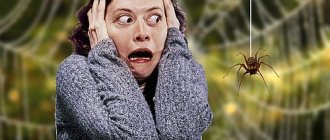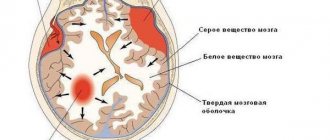- Treatment of fear
- Treatment of fears in adults
- Treatment of fear in children
- Treatment of obsessive fears
- Treatment of panic fear
- Beta blockers
- Antidepressants of various categories
- Tranquilizers
- Neuroleptics
- Psychotherapeutic assistance
- Rational method of psychotherapy
- Treatment of phobias using NLP
- Cognitive-behavioral method
- Treatment of fears with hypnosis
Many people have experienced a feeling of fear in their lives. For most, these are isolated cases and they are quite normal. But it happens that the fear of something becomes a real obsession and plunges a person into severe panic. For example, someone is deathly afraid of the dark, closed spaces, round or piercing objects, and other things. There are also completely exotic causes of fear, for example, clowns.
Uncontrollable, pathological fear cannot be rationally explained. However, this mental disorder cannot be called a rare phenomenon. Moreover, the first attacks often occur in childhood. Even then it is necessary to begin treatment of fear, otherwise over time it may take the form of a phobia. The first symptoms may first appear in an adult. In any case, the disease cannot be ignored. Therapy should be started as early as possible, otherwise it may remain with the patient for life.
Pathological fear is expressed in the form of a non-standard, abnormal, inadequate reaction to completely ordinary, harmless things and situations. People suffering from such disorders are no longer able to live a normal life. Domestic inconveniences are possible. For example, a person who cannot stand confined spaces cannot ride the elevator and is forced to constantly use the stairs.
You need to understand that any fears exist only in the patient’s head. Obsessive fear is a mental disorder that manifests itself in the form of an uncontrollable feeling of anxiety and panic. Moreover, it occurs at a moment when the person is not really in danger. Panic attacks significantly complicate the patient’s life. They limit his freedom, correct his behavior, force him to avoid certain things or situations. A person simply needs treatment for fears and anxiety; without the help of specialists, he will not be able to return to a full, happy life.
Features, types and symptoms
A distinctive feature of an anxiety disorder is that a person withdraws into himself, limits social contacts, feels insecure, and stops further development in any field of activity. As a rule, it occurs as a response to negative social factors and stressful situations.
Important: only a qualified specialist can distinguish between normal and pathological manifestations after carrying out diagnostic measures and testing. Often, fear or anxiety can appear as an expedient, protective mechanism under certain circumstances.
The classification includes several types of anxiety disorder:
- Anxious-depressive type. A person experiences anxiety constantly, although there is no real threat to safety. Typically manifests itself in pathological behavioral reactions or deterioration in general physical health
- Anxious-phobic. The emergence of an obsessive feeling of danger. The precursor is previous psychological or physical trauma. Future fears can also arise from fears that past situations will repeat again and cause harm to the person.
- Social. The patient reduces the number of contacts with other people to a minimum. Even with the most ordinary observation, a feeling of discomfort may arise. Even small criticism is taken very painfully
- Adaptive. Changing your permanent place of residence or adapting to other new conditions is difficult
- Organic. Develops due to the occurrence of another somatic disease. Most often, anxiety is accompanied by headaches of varying intensity, memory impairment, disruptions in the gastrointestinal tract and cardiovascular system
- Mixed. At the same time, signs of anxiety and a decrease in emotional background appear.
Regardless of the type of anxiety state, a number of symptoms can be identified:
- Increased emotional stress, periodically developing into panic attacks
- Sudden change of mood
- Disturbances in sleep cycles
- Often conflict situations arise with other people
- Slow thinking, reduced reaction
- Sweating increases
- A person gets tired quickly, which causes loss of performance
- Pain syndrome in various parts of the body.
In addition to general symptoms, there are specific features for each type of anxiety disorder. Signs of anxiety can arise in any area of activity: at work, in everyday life, in school. As for the anxious-depressive type, it has the following specific symptoms:
- A person ceases to be interested in events that happen in the lives of relatives and friends
- Positive emotions occur less and less often
- There is a genuine feeling of fear
- Pathologies of a vegetative nature: the pulse quickens, sweating increases, and often a person may lose consciousness.
Depending on the individual reaction of the body, other side symptoms may occur.
Types of hypnosis
The main task of introducing a person into hypnosis is to gain control over his fears, experiences, addictions and physical condition.
According to the degree and methods of influence, the following types of hypnosis are distinguished:
- Classical (directive) hypnosis. Direct influence method, in which the individual voluntarily agrees to conduct a session and fulfills the hypnologist’s conditions.
- Ericksonian (permissive) hypnosis. Unlike the classical method, in this case the suggestions are soft, unobtrusive.
- Regressive hypnosis. While in a deep trance, the subject remembers past events in detail, without controlling his consciousness.
- Self-hypnosis - works through body relaxation, concentration and self-hypnosis of positive attitudes.
Allows you to quickly relax at home, cope with stress, take control of your feelings and sensations, normalize sleep, learn to manage emotions and desires. For the successful practice of self-hypnosis, regular exercises are necessary, leading to the harmonization of the soul, body and the surrounding world.
How to treat fear and where to look for help?
It is almost impossible to cope with attacks of fear on your own. Taking medications without the supervision of specialists can lead to a worsening of the condition and physical manifestations of the disease. Often a person does not understand what is wrong with him and goes to see doctors who have nothing to do with the treatment of mental disorders. Thus, precious time is wasted, the disease progresses, prescribed medications do not work, and new symptoms of the disorder appear. As a result, a person may completely despair, lose faith in healing, and give up.
Treatment of fears by specialists of the Salvation clinic is based on psychotherapy sessions. In extreme cases and during exacerbations of anxiety disorders, the patient may be prescribed medications (sedatives or antidepressants). But it should be noted that the emphasis in getting rid of obsessive fears is still placed on psychotherapy, since long-term, regular use of medications often leads to addiction and side effects.
Treatment of fears and phobias at the Salvation psychiatric clinic begins with identifying the true causes of the disorder that served as the impetus for the onset and development of the disease. The goal of specialists is to normalize the nervous system and mental state of the patient, provide comprehensive support, and develop an individual, effective treatment regimen.
Specialists at the private clinic “Salvation” will help you face your fears with confidence! With us you will return to a full life, find peace and confidence in the future without phobias and anxieties!
Questions and answers
How dangerous is it if there is no treatment for a phobia?
If you do not seek the help of specialists, uncontrollable fear and its manifestations will only intensify. This will ultimately affect all areas of life, and you will become isolated on yourself and your problem. Therefore, it is best to start treatment as early as possible.
Is it necessary to take medication for a phobia?
The advisability of using medications is determined only by a doctor after a conversation with patients. In many cases, psychotherapeutic techniques can be used.
Is it possible to get rid of fear forever?
In mild cases, it is enough to undergo a course of psychotherapy, and you will see how your attitude towards life and unmotivated fear will change. Severe variants of the disorder may take longer. If you try to do this yourself, you may get the opposite result.
Why do fears arise?
Fear in normal manifestations can often serve as a defense mechanism if danger is imminent. However, in the absence of such a condition, the emergence of unreasonable anxiety or fear for one’s own life is a pathological mechanism that arises for many reasons.
Psychological trauma
When a person experiences a series of negative events, he or she may develop a fear or phobia of repeating the negative experience or event in the future. The occurrence of psychological trauma can be caused by negative childhood memories, loss of loved ones, and accidents.
In the process of work, specialists first of all try to find out what painful cases occurred in a person and became the provoking mechanism.
Learning result
As a result of negative experiences, a person may be afraid of specific objects, people and situations. Since the brain transmits, remembers, and classifies events that occur, when they are repeated, a person develops a feeling of fear. The main symptom will be a situation that caused negative emotions and physiological pain in a person.
An interesting fact is that this concept arose during the development of behaviorism and was proposed by J. Watson. According to his theory, the emergence of fear is due to numerous repetitions of traumatic stress and negative experiences.
Genetic memory
Genetic memory has the following features:
- If consciousness is suppressed, a person may experience abstract images, experiences, sensations
- In case of stable repetition of life situations, some reactions can be inherited
- The experience of entire generations is imprinted in the family, having a genetic nature and a method of transmission.
For example, a feeling of fear may not necessarily arise from a situation experienced independently. If one of your close relatives took part in hostilities when the child was conceived, then the child may develop unreasonable fear, poor sleep and nightmares in the future.
Neurotic projection
This is a neurotic type mechanism through which a person transmits his negative feelings and experiences, ideas and images to other people. Accordingly, when a person experiences a feeling of fear, memories of negative experiences of communication and personal relationships that he projects onto other people may arise in his mind. As a result, she begins to experience fear that the negative experience will be repeated again with other people.
Low emotional tone
If we turn to the Hubbard scale of emotional tones, then the feeling of fear implies anxiety over the fact that other people may try to “crush” a person and experience aggression towards him. In addition, fear manifests itself in the plural and with various emotional connotations. Fear of anxiety. It suggests indecisiveness in a person’s actions, the emergence of fear even in usual affairs.
It can develop as a natural species or a social one. It is important to take into account that at a normal pace of life, every person cannot be in this state all the time. If this happens, then fear is an obsessive pathological condition.
Secondary benefit
If a person regards the feeling of fear as not a problem, but an advantage that allows him to receive some “indulgences,” then this syndrome is called secondary benefit. This effect does not cause symptoms, but it contributes to the fact that fear accompanies a person for a long time. In addition, secondary gain often becomes one of the main causes of hysteria.
Benefits
- You save YOUR time. The average time to eliminate one experience, fear, is 2-3 hours.
- You save YOUR money.
- Effective. You get 100% results here and now. A processed client request will not be returned in the future. Those. the client is forever freed from processed fear, for example, fear of speaking.
- Effective. Effective against phobias, fears and worries 99%. Of all my clients, with only one the technique did not give the desired results due to the lack of a client-psychologist report (personal factor).
- Just. The EMDR technique is very easy to use, as you will soon see.
- Available. You can use it yourself, even when traveling by train, car or plane.
— 100% applicability to any age (starting with children 3 years old and older).
Confirmation of the effectiveness of the technology.
So, this technique works in a short time and its effectiveness is extremely high: this is the technique that EMERCOM psychologists use in hot spots, in places of terrorist attacks. This equipment is also included in voluntary insurance in Europe and the States. The only limitation is dysfunction of the cerebral cortex. Such people are contraindicated to experience strong emotions.
Treatment of fear
The treatment process largely depends on the individual developmental characteristics of the person, the reasons that caused this condition, as well as the age category. Only after collecting a high-quality anamnesis, specialists select a program to combat fear. As a rule, it involves a set of measures, including medications and psychotherapeutic methods.
Treatment of fears in adults
Among the most common types of treatment for adult patients are the following:
- Cognitive-behavioral technique. It is considered one of the most effective methods. Considering the formation of a phobia or fear from a cognitive point of view, the provocation of this state is carried out by illogical and inconsistent thoughts. By changing their structure, you can get rid of the obsessive state. At each psychotherapy session, a person must learn to accept his own thoughts and how they affect the emotional and behavioral aspects
- Drug therapy includes several groups of drugs: antidepressants, tranquilizers, anxiolytics, sedatives and antipsychotics
- Hypnotherapy. Almost every person knows that the effectiveness of hypnosis as a psychotherapeutic method was described by S. Freud. When properly organized, it allows you to quickly get rid of pathological fear or phobia.
It is important to note that recently the latter method has also been used to treat children and shows consistent positive results.
Treatment of fear in children
If a child suffers from an obsessive feeling of fear, then parents should make an appointment with a child psychologist or psychotherapist. This is due to the fact that in childhood a feeling of fear and danger easily arises. In addition, the child most often does not make verbal contact, and therefore the following methods of influence are used:
- Therapeutic drawing (art therapy). Using the drawing, you can diagnose the main causes of the phobia, since the projection appears on the sheet. So. For example, if a drawing appears gloomy, through a symbolic method he can “banish” his fear, turning it into something positive and funny
- Therapy through gameplay. By engaging in this type of activity, the baby begins to open up and can show the reasons why he has persistent fear. This could be an insult to close relatives, friends at school or kindergarten
- Therapy through fairy tales. The plot of the fairy tale projects the child’s way of life. When composing a story, it is easy to understand what exactly the child is afraid of and how he tries to cope with this condition
- Eriksonian hypnosis. A gentle method through which you can achieve the most effective results. Suggestion is much easier for a child than for an adult, due to their rich imagination.
Most methods are universal and can be used in treatment for adults and children. Often there are no side symptoms.
Treatment of obsessive fears
The treatment process is formed depending on what served as the stimulus for the development of the obsessive state. As a rule, the work of specialists is required for the following fears:
- Of death
- Loss of consciousness
- Outburst of aggression towards another person
- Incurable disease
- When something new and unexplored arises
- Loss of control in everyday life
- Using public transport.
If obsessive fear radically changes a person’s life in a negative direction, then you definitely need to turn to a specialist for help. Among the most common methods are:
- Hypnosis
- Cognitive psychotherapy.
However, to achieve the most effective result, several methods of influence are often used at once.
Important: obsessive behavior is a pronounced negative form of reaction in a wide variety of situations. Therefore, it is first important to find out what the causes of its occurrence are in order to choose the right treatment.
Treatment of panic fear
Panic fear can arise as an isolated phenomenon, but in practice, situations most often occur when it is a complementary component to developing neuroses, hysteria, and phobias. There are several effective treatment methods:
- Taking medications. They help in an unexpected moment to get rid of a panic attack. The most common drugs that can be purchased at a pharmacy without a prescription include: Validol, Glycised, tinctures of Valerian and motherwort. However, it is not recommended to use them too often, only in extreme cases when independent control is powerless
- Understanding the cause. This is necessary so that the specialist and the patient himself understand what specific fear he needs to fight.
- Keep a diary. In practice, this option will help you clearly articulate your experiences and feelings. It is advisable to describe the situations occurring in as much detail as possible. This helps a person to independently understand his own thoughts, events, and, if necessary, reassess
- Meditation. It is important to understand that a panic attack occurs for no reason, as a result of fantasizing about negative moments or incidents. Meditation will help restore internal balance and return to a normal, calm state.
It is important to note that it is necessary to treat panic attacks as early as possible so as not to increase the number of developing phobias or provoke an exacerbation of existing diseases.
Symptoms of a panic attack
A person in this state experiences an uncontrollable attack of fear. It is characterized by the following manifestations:
- Cold sweat
- An attack of panic or anxiety
- Migraine
- Blackout
- It starts to get dark in the eyes
- It becomes difficult to breathe
- Limbs begin to tremble
Let's look at panic attacks from the physiological side.
After a person experiences stress, our body reacts to it. The first reaction: release adrenaline into the blood. Next, the blood vessels decrease, breathing becomes more intense, and the heartbeat accelerates. The result is hyperventilation of the lungs. There is a rapid accumulation of lactic acid in muscle tissue. Pain appears in the body. And all this together tells the brain that the body has just experienced stress.
Next, our body understands that it has just experienced a state of stress, but such a state was not obtained without a reason, as a result the body reacts with a panic attack. It must be said that people who are not susceptible to panic attacks react differently to minimal stress.
If you experience panic, fear, or anxiety before an event, such as a job interview, a final exam, a public speech, an important conversation with a loved one, or other similar events, then this is normal. This is a natural reaction of the body and nervous system before a significant event in your life.
But if you or a loved one is experiencing all of the above symptoms without a compelling reason or a threat to life, then it may very well be a panic attack.
“Do you suspect yourself or someone close to you is having a panic attack?
Get a consultation at the psychiatric department of the KORSAKOV clinic."
Treatment of phobias with medications
Drug treatment is not fundamental in combating phobias. As a rule, such a measure is regarded as auxiliary. First of all, they are necessary in order to eliminate the manifestations of side symptoms, but they do not eliminate the cause. Depending on the group of drugs used, somatic or psychological side symptoms disappear.
To get rid of persistent phobias, it is imperative to follow the instructions of specialists, as well as adhere to the prescribed dosage.
Beta blockers
Necessary for relief of somatic manifestations. The mechanism is based on blocking the production of hormones responsible for stress. They do not help eliminate the psychological aspects of the disease, but actively eliminate the physiological manifestations. As a result, the patient’s condition begins to stabilize and the emotional background improves. This is due to the fact that phobias often develop according to the following pattern:
- Formation of fear
- Symptoms at the physical level
- Increasing the impact of fear as a result of the physiological aspect.
As a result, in a situation where physical condition improves, the impact of fear on the psyche decreases.
Antidepressants of various categories
If the patient’s condition worsens and becomes extremely severe, it is impossible to formulate treatment without antidepressants. Among the most common groups of medications are tricyclic and heterocyclic drugs, as well as selective inhibitor drugs, the serotonin and norepinephrine uptake group.
Tranquilizers
A group of drugs whose action is aimed at relieving severe anxiety. But their use for a long time leads to the fact that the body begins to get used to their action. Unfortunately, this side symptom is difficult to get rid of.
Benzodiazepine, Meprobamate or Hydroxyzine are gentle drugs, but even their use must be carried out in strict accordance with doctors' prescriptions. However, most often long-term treatment is not prescribed. There are other drugs that quickly relieve the patient of anxiety: Clonazepam, Elenium.
Neuroleptics
The use of antipsychotics is relevant in a situation where the patient has serious behavioral disorders or serious physiological symptoms. A person may show unreasonable aggression, be suicidal, and have severe hallucinations. With their help, an increased response to external stimuli is quickly blocked.
Despite the fact that the patient gains long-awaited calm, he experiences increased drowsiness, fatigue, and a decrease in reaction speed. Because of the serious side symptoms, their use is used exclusively in difficult situations when other drugs are not able to have the desired effect. It is possible to obtain medications from a pharmacy only with an official prescription from a doctor.
Method of using hypnosis in psychiatry
A specially developed method that provides for the treatment of mental illness using hypnosis. This method is quite widely used and successfully used in the prevention and treatment of many diseases that are associated with mental disorders. In addition, it is used in the treatment of physical problems of the body, for example, when there are problems with the spine.
Related posts:
- Insomnia or insomnia Insomnia or insomnia is the most common manifestation of sleep disturbance. By…
- Female Sexual Arousal Disorders Sexual arousal disorders were previously known as frigidity in women...
- Depersonalization or lack of perception of one’s own self Derealization-depersonalization syndrome is a mental disorder in which a person feels...
- Necrophobia: Fear of the Dead One specific type of fear or anxiety disorder is necrophobia...
Psychotherapeutic methods for treating phobias and fears
All methods used in psychotherapy are aimed at finding out the causes of phobias and fear with further elimination, rehabilitation and restoration of the patient’s normal state. The main working methods include the following:
- Psychotherapeutic help
- Rational methods
- Neurolinguistic programming (NLP)
- Cognitive-behavioral method
- Hypnosis techniques
- Different methodology.
Features of hypnosis for neurosis
Hypnosis sessions for neurotic conditions primarily identify the cause of their occurrence. This occurs while the patient is immersed in a hypnotic trance, when the hypnologist finds a negative event in his subconscious, changes the interpretation of the painful situation, which helps to develop a new reaction to it.
Benefits of hypnotherapy:
- It is designed for 5 sessions, while other methods last for years.
- It not only gets rid of the cause of the painful condition, but also forms the basis of behavior that will help cope with similar problems in the future. She helps the patient change his irrational, dysfunctional beliefs to constructive ones.
- It does not cause discomfort, addiction or side effects in the patient, unlike medications.
The whole process of hypnotherapy takes place in stages:
- Preliminary diagnosis of symptoms, consultation regarding hypnotherapy.
- Conducting a hypnosis session.
- Preventive work aimed at preventing relapses of a neurotic state.
Psychotherapeutic assistance
In this case, the work should be joint: the psychologist and the patient. In the process, they must exchange information, talk through possible experiences, develop the situation, talk it through and further resolve it.
Conventionally, the entire process can be divided into the following stages:
- Information on a psychological level
- Consultation with a psychologist
- Correction (perception, behavior).
The main feature of information treatment is the provision of information about the patient’s disease, its causes, as well as psychological processes that are initiated in the brain.
During the consultation process, a person should acquire a number of practical knowledge that he can use in the future if a critical situation arises. The experience gained helps you independently control manifestations of fear and become familiar with new technical methods. The main task of the psychologist is to transfer and teach the client to apply new knowledge in practice.
When a person receives psychological help, as a rule, the impact is divided into situational and sequential interaction, which consists of several stages. If the patient is going through a crisis stage, then it is advisable to use shock methods of work. To restore social interaction with other people, adaptation in society at the social level, it is important to use flexible step-by-step work.
To get rid of phobias and psychological illnesses, the following techniques are often used:
- Psychodynamics. Identification and further work with memorable situations and events
- Behavioral. Correcting the patient’s current behavior, reducing difficulties at the social-adaptive level
- Existential. Coping with Social Difficulties
- Humanistic. Development of the patient's abilities and its further use.
Rational method of psychotherapy
The method allows you to cure a phobia and side symptoms using an objective assessment and the patient’s logical conclusions. If a person has a phobia identified, then he receives full information about what it is, as well as what its somatic nature is. If the patient begins to understand the essence of the disease, he stops looking for a relationship with physical disorders, and therefore the level of anxiety decreases.
Treatment of phobias using NLP
It is advisable to use NLP for phobias, where a technique called “Score” is relevant. Translated into Russian, the structure of the program assumes the following scheme of work:
- Symptoms
- Cause
- Result
- Resources and effect.
Together with the patient, the psychologist collects the maximum amount of information material, then conducts an analysis and checks. The process can then be divided into the following stages:
- Information about how the disease manifests itself
- The patient must independently formulate a goal of what will be worked on
- Analysis of how effective the work is. If the client is satisfied with the result obtained, this aspect motivates him to achieve new goals. If negative results are obtained, the work is moved back one step, where the assigned tasks are adjusted
- If necessary, the mechanisms of formation of phobias can be discussed. If there is no need for this, then this stage is simply ignored
- Determining the resources that need to be used to achieve the goals.
Thanks to this technique, you can obtain the maximum amount of information within a short period of time, and then use all your efforts and resources to implement the assigned tasks. The NLP technique helps to achieve high results. Sometimes just a couple of sessions are enough to eliminate phobias. Among the most common methods are the Swing technique or kinesthetic association.
Cognitive-behavioral method
According to information from the Ministry of Health, WHO and the USA, the cognitive-behavioral method is considered the most effective in the treatment of phobic conditions. Thanks to numerous methods and techniques, we help select a treatment package for each patient on an individual basis.
The main point is for the patient to determine, with the help of a specialist, which attitudes are emotionally negative and cause increased anxiety. When a person begins to ask himself questions, he begins to draw conclusions on his own. As a result of qualitative analysis, the patient actively distinguishes between positive and negative aspects in existing social, psychological and moral attitudes.
As a result, the cognitive-behavioral method helps to replace negativity and pessimism with more positive emotions. The following idea can be highlighted as the main thesis: the patient’s sense of self depends on what thoughts and attitudes are in his head. During the treatment process, a person, under the supervision of a specialist, is able to simulate various situational tasks and then determine the correct reaction. As soon as the theoretical part is fully worked out, it’s time to move on to practical actions.
As it progresses, the person begins to improve their behavioral and cognitive skills. At the same time, the specialist constantly increases the complexity. As a result, the client can reconsider his own behavior, as well as eliminate a negative attitude, which often becomes one of the main reasons for the development of phobias.
The end result is the restoration of a normal emotional background without anxiety, excessive aggressiveness and excessive pessimism.
Treatment of fears with hypnosis
Hypnosis remains an unconventional method of working against many psychological ailments to this day. There is still active debate around it, as well as how effective it is. From a medical point of view, it is believed that hypnosis is a full-fledged method that can be classified as an unconventional branch. With its help, you can achieve surgical treatment of phobias. However, in practice, this technique is used much less frequently.
The main function is to work with the unconscious state of the patient, where protection is turned off at the psychological level. As a result, the patient can relax and concentrate on the treatment process itself. Next, the specialist programs the necessary settings using suggestion.
What you can do yourself
It is also important that the patient himself takes an active part in eliminating pathological fear. Treatment of phobias should include a review of lifestyle. It is very useful to restore the nervous system, as directed by a doctor, to do the following:
- meditate;
- practice auto-training;
- sign up for a relaxing massage;
- study and practice breathing exercises daily;
- get enough sleep;
- eat properly and nutritiously;
- get rid of bad habits.
If a person withdraws into himself and doesn’t really want to fight his “demons,” shows passivity and unwillingness to change, then the help of even the best specialists will be incomplete or short-lived. In this case, close people can be advised to talk to him, lend a helping hand and explain why and for what purpose treatment is required.
Under no circumstances should you try to help a person overcome his horror by trying to confront him with the object of his fear. Severe fear can harm mental health. And vegetative manifestations, especially in older people, can lead to heart attack or stroke.
If you have a sincere desire to completely get rid of phobias and a desire to overcome your fear, a positive result will definitely come. After this, changes will occur in life itself, which will pleasantly please and bring
Cost of services
| TREATMENT OF DEPRESSION, NEUROSIS | |
| NAME OF SERVICE | price, rub. |
| Consultation with a therapist (observation) | 3,000 rubles |
| Consultation with a neurologist (observation) | 3,000 rubles |
| Consultation with a psychologist | 2,000 rubles |
| Psychiatrist consultation | 5,000 rubles |
| Consultation with the head of the department | 4,500 rubles |
| CONSULTATIONS, INITIAL INSPECTION | |
| NAME OF SERVICE | price, rub. |
| Telephone consultation | For free! |
| Telephone consultation for relatives | For free! |
| Initial consultation with a psychiatrist-narcologist in a hospital | For free! |
| Initial consultation with a psychologist by phone | For free! |
| Visit of a narcologist and consultation at home | 2,000 rubles |
| Consultation with a psychotherapist, psychologist in the clinic | 2,000 rubles |
| Initial appointment, examination by a doctor, cubital catheter, ECG | 2,500 rubles |
| Consultation with a therapist, neurologist, surgeon | 3,000 rubles |
| Family consultation with a psychologist | 3,000 rubles |
| Psychiatrist consultation | 4,000 rubles |
| Consultation with the head of the department | 4,500 rubles |
| PROMOTIONS AND DISCOUNTS | |
| When applying again | 5% discount on treatment |
| Disabled people and war veterans | 5% discount on treatment |
| Large families | 10% discount on treatment |
* Dear patients! The administration tries to promptly update the price list posted on the website, but in order to avoid possible misunderstandings, we ask you to clarify the cost of services on the day of your call by calling 24/7.
The posted price list is not an offer.
Get a free consultation
+7(495) 798-30-80
Is it possible to cope with anxiety on your own?
You can live with anxiety, and a person adapts: he defines a comfort zone for himself, limiting his space. If he knows that anxiety will arise under certain conditions, he may isolate himself from this situation, not move forward, and not interact with new people.
That's why some people stay in the same job for twenty or thirty years and don't take steps forward, although they have the ability. They don’t change anything in their life for decades. This is how they exist.
That's why some people stay in the same job for twenty or thirty years and don't take steps forward, although they have the ability.
The surest way to cope is with a psychiatrist or psychiatrist-psychotherapist. It is better to contact a specialist with a medical education (not a psychologist), because he will be able to prescribe drug therapy that normalizes biochemical processes in the brain.











